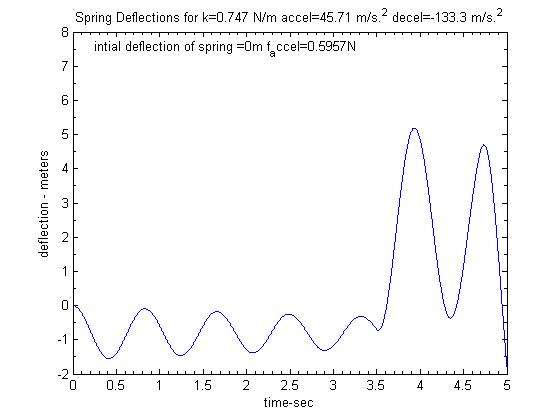PLEASE NOTE: This is the Archived Sexyloops Board from years 2004-2013.
Our active community is here: https://www.sexyloops.co.uk/theboard/
Our active community is here: https://www.sexyloops.co.uk/theboard/
Harmonic Oscillator
- Paul Arden
- Fly God 2010
- Posts: 23925
- Joined: Sat Jul 26, 2003 10:35 am
- Location: Travelling
- Contact:
Harmonic Oscillator
Hi Gordy, Merlin and team.
I've read a few interesting posts over the last few months. I think it was Merlin who stated that a rod was going to unload over a period of time, no matter what we did, and Gordy started calling the rod a harmonic oscillator, which differs from the flexible level that we often hear.
Now I've thought about this and can sort of understand the concept, however if I stick my rod out the window while driving down the motorway at 90mph the rod will bend, and it's not going to start unbending until I slow to 80.
Can you maybe explain why these two concepts differ so I/we can hopefully grasp the complete concept?
Many thanks,
Paul
I've read a few interesting posts over the last few months. I think it was Merlin who stated that a rod was going to unload over a period of time, no matter what we did, and Gordy started calling the rod a harmonic oscillator, which differs from the flexible level that we often hear.
Now I've thought about this and can sort of understand the concept, however if I stick my rod out the window while driving down the motorway at 90mph the rod will bend, and it's not going to start unbending until I slow to 80.
Can you maybe explain why these two concepts differ so I/we can hopefully grasp the complete concept?
Many thanks,
Paul
- Bernd
- IB3 Member Level 1
- Posts: 2204
- Joined: Sat Mar 11, 2006 10:55 pm
- Location: Hamburg, Germany
- Contact:
Paul Arden wrote:I stick my rod out the window while driving down the motorway at 90mph the rod will bend,
Probably the other pieces are somewhere on the rod?!
Bernd Ziesche
www.first-cast.de
www.first-cast.de
- Paul Arden
- Fly God 2010
- Posts: 23925
- Joined: Sat Jul 26, 2003 10:35 am
- Location: Travelling
- Contact:
i believe there may be more than one type of oscillation happening.
Bruce Richards mentioned to me some years ago the fact that a rod vibrates in an S wave over time. Here is a gif animation of Henry Mittel stopping a rod and the aftermath.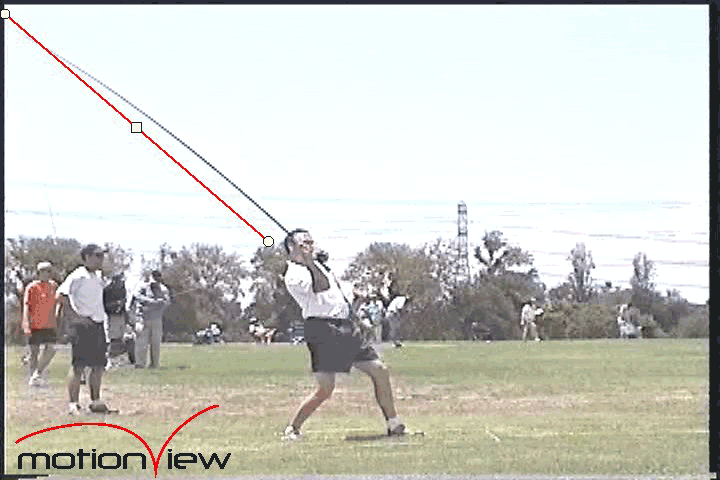
This can be enough to put a wave in the line causing the line to tick later in the cast. I have video of a secondary rod rebound causing a slack loop at the rod tip that creates a wave in the line.
Bruce Richards mentioned to me some years ago the fact that a rod vibrates in an S wave over time. Here is a gif animation of Henry Mittel stopping a rod and the aftermath.

This can be enough to put a wave in the line causing the line to tick later in the cast. I have video of a secondary rod rebound causing a slack loop at the rod tip that creates a wave in the line.
tp://CastFlys.Com]CastFlys.Com[/URL]
-
gordonjudd
- IB3 Member Level 1
- Posts: 2214
- Joined: Mon Jul 10, 2006 12:14 am
- Location: California
- Contact:
however if I stick my rod out the window while driving down the motorway at 90mph the rod will bend, and it's not going to start unbending until I slow to 80.
Paul,
No one understands my explanation of how a forced harmonic oscillator operates, so you will want to ask some more questions about this so Merlin can give a better answer.
You are not seeing a harmonic oscillator effect when the car is moving at a constant velocity. In that case with no acceleration the rod will take on a bending profile such that the effect of the drag forces along the blank will be offset by the opposing deflection force related to the spring constant of the rod.
That will come to a steady state condition (in reality the rod tip would flutter around like a flag in a steady wind) where the bend in the rod will depend on the aerodynamic drag forces on the rod. As you go faster the drag forces will increase and the rod will take on a bigger deflection to equalize them. With constant velocity the rod bend will come to a “steady state” condition where the deflection force from the spring in the rod (k*x) will equalize the normal and skin drag forces that oppose the movement of the rod through the air.
When you accelerate the rod you get a different effect that is related to the response of a spring/mass system when an acceleration force is applied to one end of the spring, That acceleration force will establish a new steady state deflection force in the spring such that k*x (the spring constant times the deflection) will equal the F=ma force that is related to acceleration of the spring/mass system.
As described here, if you were to deflect the spring with some pre-load that matched the new equilibrium position, then the deflection in the spring would remain at that constant deflection point for as long as the acceleration was held constant. With that initial condition the mass would not oscillate and you would have a steady state deflection where the k*x force in the spring would be equal to the F=ma force associated with the constant acceleration.
As you know if you suspend a mass from a spring it will deflect by some amount such that the deflection force in the spring will just balance the F=mg weight of the mass. That establishes an initial equilibrium point for the spring/mass system. Now as described here if you displace the spring from that equilibrium point and release it will oscillate up and down at some frequency related to 1/(2.*pi)(sqrt(k/(mo+m)) as described in a number of threads in this forum.
We generally do not accelerate the rod long enough for it to start unbending on its own, so a thought experiment might better illustrate what would happen when a spring mass system undergoes acceleration over a long time period.
Just so we do not have to worry about drag forces let’s assume we have our spring/mass system attached to a strut so that it can be observed from inside the lunar lander on the moon. When the lander's rockets are fired to apply an acceleration to lift it off the moon, the equilibrium point for the deflection in the spring is shifted to a new point as described above. Thus the initial deflection in the spring is offset from the new equilibrium point where it wants to be because of the applied acceleration.
Thus just like the case described in the Wikipedia article when the mass was pulled down from its static equilibrium point and released, the mass will start to oscillate about the new equilibrium point that depends on the magnitude of the acceleration and the spring constant of the spring (F=ma=-kx) where x is the new equilibrium deflection point.
Thus looking out the window you would see the deflection in the spring increase to a maximum deflection point that overshot the new desired equilibrium position (determined by the magnitude of the lander's acceleration) by the same amount as the initial offset deflection just like it does in the simple harmonic oscillator motion illustrated in the Wikipedia article. As long as the module maintained its constant acceleration the mass would continue to oscillate about the new equilibrium position as shown below.
When the module decelerated to join up with the command module, that would establish a new equilibrium position that requires the spring to be compressed by some amount F=-xk=m*deceleration.. Depending on the deflection of the spring when the change in acceleration goes from its positive to negative the mass will oscillate about the compressed deflection position with much larger values (since the deceleration is much larger than the acceleration) for as long as the deceleration is applied.
Thus if we could sustain a large constant acceleration time in rotating the rod it would oscillate just as it did in our thought experiment, but in practice we do not have enough rotation angle to allow that to happen.
A very stiff rod (like Alejandro’s broomstick rod) might show that self-unbending while the rod was still being accelerated since it would have a much higher loaded oscillating frequency. Some good high speed videos would show if that actually happens or not.
Gordy
"Flyfishing: 200 years of tradition unencumbered by progress." Ralph Cutter
Hi Paul
I shall try to explain.
Let’s start by the car. As you drive at 90 mph, the rod goes under equilibrium: air drag force on one side, spring force on the other side, so it remains flexed backwards. It will not move from this equilibrium until you decelerate to any speed. The way you decelerate is important. If you do it very gently, the rod will unbend progressively until you stop. If you pull hard on the brakes, it will bend forward with energy immediatly (there is a lot of kinetic energy in the rod at 90 mph).
Now if we take the fly cast, all is extremely dynamic, there is no equilibrium point for the rod. I said the rod will unload over a period of time even we keep on accelerating. The problem is to be able to be in the proper conditions to see that. Let’s take a normal cast. We believe the rod unloads only as we decelerate. This is fine even if some rods start unloading slightly before and others slightly after. It is just invisible to us; it may take a couple of frames on a high speed video. To record that, we would have to record the rotation speed with a CA and synchronize it with the video HS camera.
We could improve the experience if we could have an extremely fast rod, but there is none on the earth. On the other side, we might experiment the opposite situation with a noodle, which can unload during the deceleration phase of a quick cast.
It is also impossible for us to keep on accelerating in a very large space frame, which would allow witnessing the rod unloading after some time. The only solution is to cast very slowly to increase the time for acceleration. Not sure it will be enough.
I do not make a difference between the SHO concept and the flexible lever concept (but it must be elastic). An elastic lever is an SHO.
Merlin
I've read a few interesting posts over the last few months. I think it was Merlin who stated that a rod was going to unload over a period of time, no matter what we did, and Gordy started calling the rod a harmonic oscillator, which differs from the flexible level that we often hear.
Now I've thought about this and can sort of understand the concept, however if I stick my rod out the window while driving down the motorway at 90mph the rod will bend, and it's not going to start unbending until I slow to 80.
Can you maybe explain why these two concepts differ so I/we can hopefully grasp the complete concept?
I shall try to explain.
Let’s start by the car. As you drive at 90 mph, the rod goes under equilibrium: air drag force on one side, spring force on the other side, so it remains flexed backwards. It will not move from this equilibrium until you decelerate to any speed. The way you decelerate is important. If you do it very gently, the rod will unbend progressively until you stop. If you pull hard on the brakes, it will bend forward with energy immediatly (there is a lot of kinetic energy in the rod at 90 mph).
Now if we take the fly cast, all is extremely dynamic, there is no equilibrium point for the rod. I said the rod will unload over a period of time even we keep on accelerating. The problem is to be able to be in the proper conditions to see that. Let’s take a normal cast. We believe the rod unloads only as we decelerate. This is fine even if some rods start unloading slightly before and others slightly after. It is just invisible to us; it may take a couple of frames on a high speed video. To record that, we would have to record the rotation speed with a CA and synchronize it with the video HS camera.
We could improve the experience if we could have an extremely fast rod, but there is none on the earth. On the other side, we might experiment the opposite situation with a noodle, which can unload during the deceleration phase of a quick cast.
It is also impossible for us to keep on accelerating in a very large space frame, which would allow witnessing the rod unloading after some time. The only solution is to cast very slowly to increase the time for acceleration. Not sure it will be enough.
I do not make a difference between the SHO concept and the flexible lever concept (but it must be elastic). An elastic lever is an SHO.
Merlin
Fly rods are like women, they wont´play if they're maltreated.
Charles Ritz, A Flyfisher's Life
Charles Ritz, A Flyfisher's Life
-
gordonjudd
- IB3 Member Level 1
- Posts: 2214
- Joined: Mon Jul 10, 2006 12:14 am
- Location: California
- Contact:
On the other side, we might experiment the opposite situation with a noodle, which can unload during the deceleration phase of a quick cast.
Merlin,
Did you mean to say it can continue to load (increase its deflection) for a short time period after the deceleration was initiated?
I would think any rod would start to unload at some point during the deceleration phase. But I could see that a slow rod would have more lag in responding to a change in the input at the butt of the rod, and thus could continue to load immediately after the deceleration was initiated.
Gordy
"Flyfishing: 200 years of tradition unencumbered by progress." Ralph Cutter
- Paul Arden
- Fly God 2010
- Posts: 23925
- Joined: Sat Jul 26, 2003 10:35 am
- Location: Travelling
- Contact:
Thanks for your answers, guys, that helps! I hadn't considered the rod vibrating to a new equilibrium position before. So what part does Frequency play in how the rod unloads and is this something we can actually feel? (Is this what we feel when we compare rods using pull-back for example?)
And what part does this second mode (mode or node?) frequency play in flycasting? I notice that I use this extensively for roll and dynamic roll casts, occasional long backcast carries, tight loops and accuracy!
Many thanks,
Paul
And what part does this second mode (mode or node?) frequency play in flycasting? I notice that I use this extensively for roll and dynamic roll casts, occasional long backcast carries, tight loops and accuracy!
Many thanks,
Paul
Gordy,
Not after the deceleration, but after the end of the acceleration.
Here is an example where the rods deflection continues to increase after the acceleration phase ends and the deceleration phase is started.
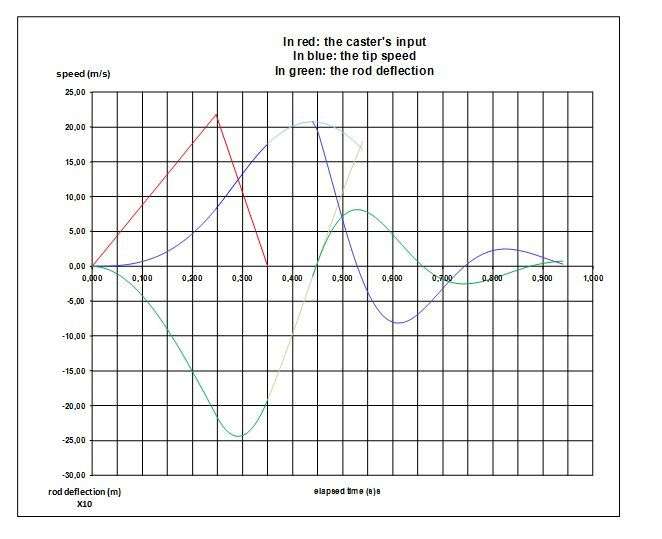
You can see that the deflection continues to increase after the deceleration is started and reaches its maximum deflection point about 50 ms after the acceleration phase ends and the deceleration phase was started.
Merlin
Not after the deceleration, but after the end of the acceleration.
Here is an example where the rods deflection continues to increase after the acceleration phase ends and the deceleration phase is started.

You can see that the deflection continues to increase after the deceleration is started and reaches its maximum deflection point about 50 ms after the acceleration phase ends and the deceleration phase was started.
Merlin
Fly rods are like women, they wont´play if they're maltreated.
Charles Ritz, A Flyfisher's Life
Charles Ritz, A Flyfisher's Life
Paul
Starting from the end: the second mode appears because rods have a number of frequencies and can exhibit several of them at the same time. I think the second mode is more related to our wrist motion. When it appears, its amplitude is small as illustrated in Grhens video.
Can you tell us "how" you use it: do you make it appear on purpose?
Frequency is the parameter of the cast. We learn to match it when we learn casting. Some are better than others to produce the most desirable timing.
I do not think it that the pull back is very much influenced, but it is for sure, an SHO does not know working without its frequency modes.
Merlin
Starting from the end: the second mode appears because rods have a number of frequencies and can exhibit several of them at the same time. I think the second mode is more related to our wrist motion. When it appears, its amplitude is small as illustrated in Grhens video.
Can you tell us "how" you use it: do you make it appear on purpose?
Frequency is the parameter of the cast. We learn to match it when we learn casting. Some are better than others to produce the most desirable timing.
I do not think it that the pull back is very much influenced, but it is for sure, an SHO does not know working without its frequency modes.
Merlin
Fly rods are like women, they wont´play if they're maltreated.
Charles Ritz, A Flyfisher's Life
Charles Ritz, A Flyfisher's Life
- Paul Arden
- Fly God 2010
- Posts: 23925
- Joined: Sat Jul 26, 2003 10:35 am
- Location: Travelling
- Contact:
Hi Merlin,
Here I am using it to show that it occurs pre-RSP1 http://www.sexyloops.com/movies/pullback.avi
Cast 1, no pull-back. Cast 2 with pull-back.
I use it for curve casts and tuck casts. But also for roll casts both dynamic and static (unless I'm going for max distance, apparently). I use it to throw tight fast loops in either direction. There does seem to be a considerable difference in line speed.
Cheers, Paul
Here I am using it to show that it occurs pre-RSP1 http://www.sexyloops.com/movies/pullback.avi
Cast 1, no pull-back. Cast 2 with pull-back.
I use it for curve casts and tuck casts. But also for roll casts both dynamic and static (unless I'm going for max distance, apparently). I use it to throw tight fast loops in either direction. There does seem to be a considerable difference in line speed.
Cheers, Paul
- Paul Arden
- Fly God 2010
- Posts: 23925
- Joined: Sat Jul 26, 2003 10:35 am
- Location: Travelling
- Contact:
-
gordonjudd
- IB3 Member Level 1
- Posts: 2214
- Joined: Mon Jul 10, 2006 12:14 am
- Location: California
- Contact:
Is it so that the the rod have a true,clean true sine wave motion?
Tom,
I assume you mean does the tip travel have a pure sinusoidal motion when it is acting like an oscillating cantilever beam. If that is the case then as you have shown the answer is no.
The impact of higher modes (mostly the second) interference on the tip motion is discussed in your tip speed and measurement thread here.
On thing that I have noticed is that you do get a very clean single sinusoid tip motion when doing frequency tests with added tip masses as shown below:
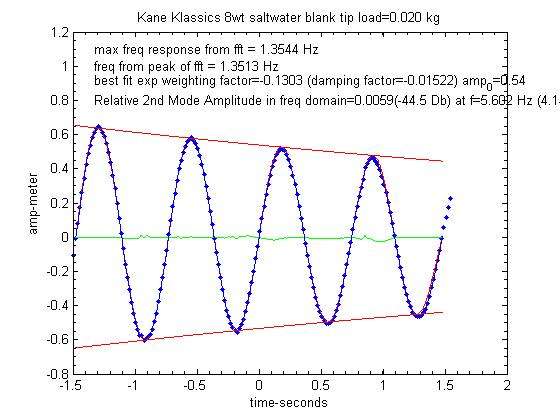
There was no discernible 2nd mode amplitude in the frequency domain response of those tip motions as shown here:
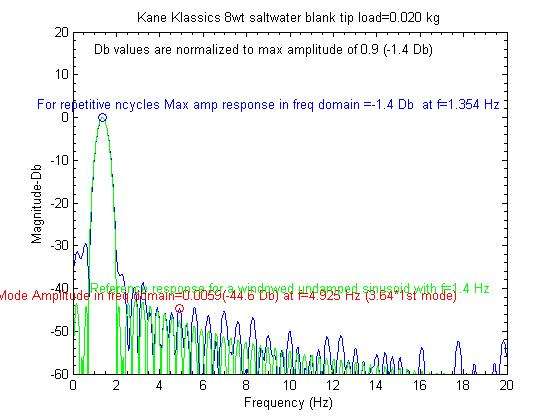
You can see the any response near the expected 2nd mode frequency is below the -50 dB noise in this plot. As you know -50 dB is a long way down. That is a relative amplitude value of .0032.
Gordy
"Flyfishing: 200 years of tradition unencumbered by progress." Ralph Cutter
Who is online
Users browsing this forum: No registered users and 0 guests



